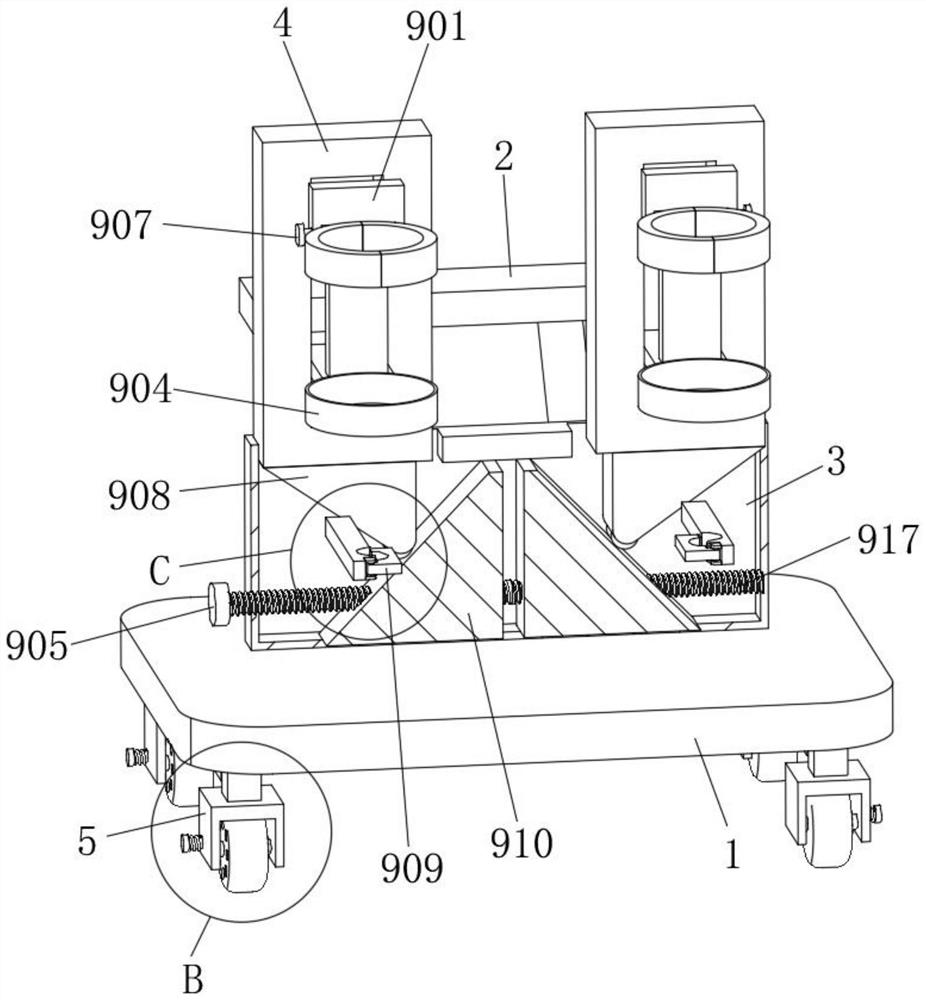Clinical hemodialysis conversion device for nephrology department
A hemodialysis and conversion device technology, applied in dialysis systems, suction equipment, etc., can solve the problems of entanglement, instability, and inconvenience of infusion tubes, and achieve the effects of preventing entanglement, reducing contact friction, and facilitating height adjustment
- Summary
- Abstract
- Description
- Claims
- Application Information
AI Technical Summary
Problems solved by technology
Method used
Image
Examples
Embodiment 1
[0034] refer to Figure 1-6 The shown hemodialysis conversion device for clinical use in nephrology includes a mounting plate 1, the upper surface of the mounting plate 1 is provided with a stabilizing sleeve 3, the inner wall of the stabilizing sleeve 3 is slidably connected with a motion plate 4, and the inner wall of the motion plate 4 is slidably connected. A support plate 8 is provided, the upper surface of the mounting plate 1 is provided with a fixed rod, the top of the fixed rod is provided with a push plate 2, the lower surface of the mounting plate 1 is provided with a protective plate 5, and the inner wall of the protective plate 5 is rotatably connected with a roller 6, The front surface of the stabilization sleeve 3 is provided with a connecting rod 7 , and the upper surface of the support plate 8 is provided with a positioning stabilization mechanism 9 .
[0035] With the above structure, by setting the stabilizing sleeve 3, the movement of the moving plate 4 is ...
Embodiment 2
[0037] Based on the above-mentioned Embodiment 1, the positioning stabilization mechanism 9 includes a vertical vertical plate 901 disposed on the upper surface of the support plate 8 , the front surface of the vertical vertical plate 901 is provided with an escape groove 911 , and the opposite sides of the left and right vertical vertical plates 901 are provided with rotating The inner wall of the rotating hole is rotatably connected with a first positive and negative screw rod 912 . By setting the rotation hole, the first front and back screw rods 912 are avoided, and by setting the vertical vertical plate 901 , the stability of the first front and back screw rods 912 is maintained.
Embodiment 3
[0039] Based on the above-mentioned Embodiment 1 or 2, one end of the first front and back screw rod 912 is provided with a second knob 907, and the surfaces of the first front and back screw rod 912 are respectively screwed with the left clamp plate 903, the right clamp plate 902, the left clamp plate 903, the right clamp The back surface of the clamping plate 902 is slidably connected with the inner wall of the escape groove 911 , and the front surface of the support plate 8 is provided with an annular ring plate 904 . By setting the second knob 907, the operator rotates the second knob 907 to drive the first positive and negative screw rods 912 to rotate. By setting the left splint 903 and the right splint 902, the first positive and negative screw rods 912 rotate to drive the left splint 903 and the right splint 902. Close to each other, by arranging the annular ring plate 904, the objects placed in the annular ring plate 904 are supported.
PUM
 Login to View More
Login to View More Abstract
Description
Claims
Application Information
 Login to View More
Login to View More - R&D
- Intellectual Property
- Life Sciences
- Materials
- Tech Scout
- Unparalleled Data Quality
- Higher Quality Content
- 60% Fewer Hallucinations
Browse by: Latest US Patents, China's latest patents, Technical Efficacy Thesaurus, Application Domain, Technology Topic, Popular Technical Reports.
© 2025 PatSnap. All rights reserved.Legal|Privacy policy|Modern Slavery Act Transparency Statement|Sitemap|About US| Contact US: help@patsnap.com



